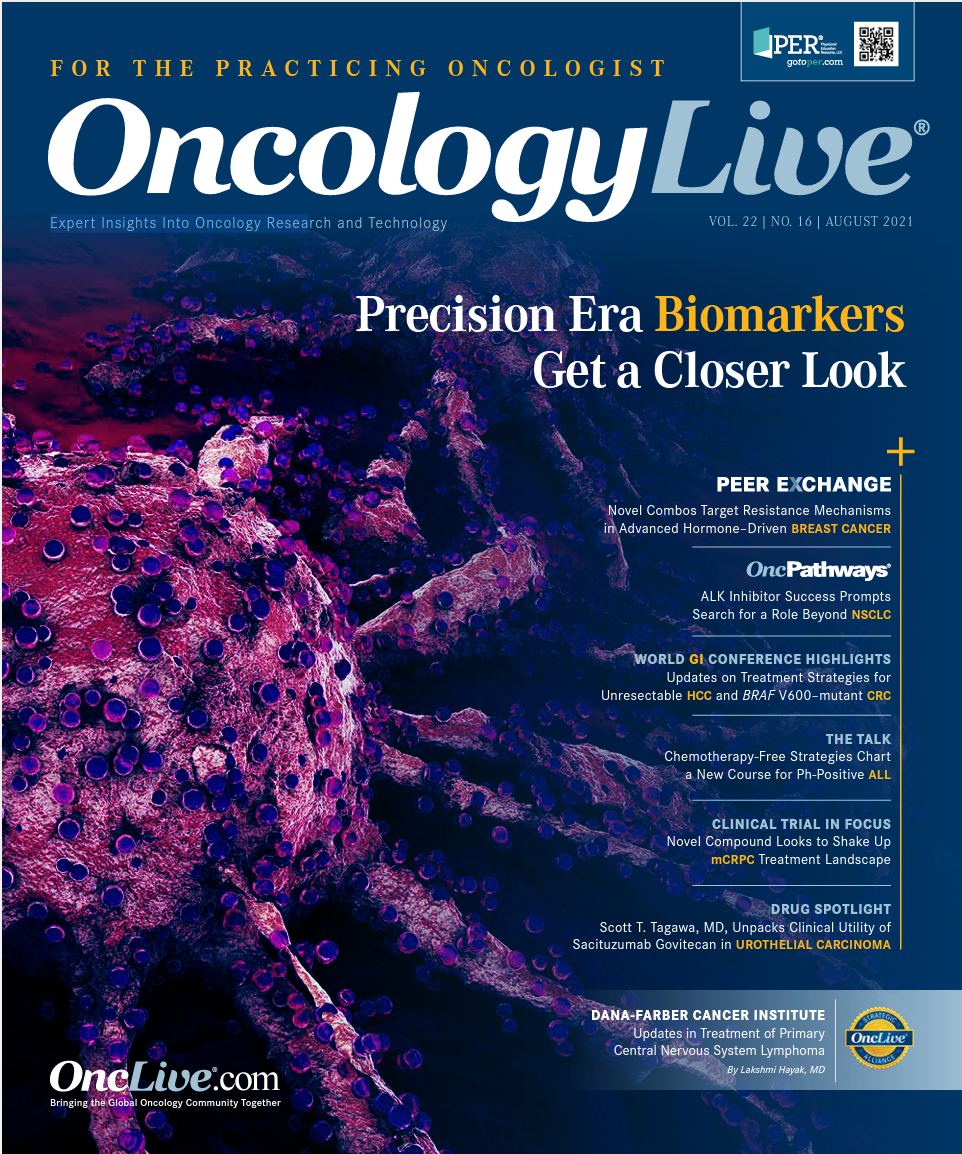Chemotherapy-Free Strategies Chart a New Course for Ph-Positive ALL
A new era for patients with newly diagnosed Philadelphia chromosomepositive acute lymphoblastic leukemia may be on the horizon as investigative efforts aimed away from chemotherapy-based regimens prove efficacious.
Jorge E. Cortes, MD

A new era for patients with newly diagnosed Philadelphia (Ph) chromosomepositive acute lymphoblastic leukemia (ALL) may be on the horizon as investigative efforts aimed away from chemotherapy-based regimens prove efficacious. The 5-year survival rates for chemotherapy in combination with f irst-generation or second-generation tyrosine kinase inhibitors (TKIs) range from 35% to 50%; however, acquired T315I mutations are a driving cause of relapse.1 Also known as the “gatekeeper” mutation, T315I increases activity of BCR-ABL mutations; previous efforts with dual inhibitors have limited efficacy and unfavorable safety profiles.2
Two agents are at the forefront of paving the way for improvements for this patient population: the BCR-ABL TKI ponatinib (Iclusig) and the bispecific T-cell engager blinatumomab (Blincyto).1 Based on prior efficacy data in combination with hyper-CVAD (cyclophosphamide, vincristine sulfate, doxorubicin hydrochloride, and dexamethasone), and as monotherapy options, respectively, the rationale to combine the 2 agents was executed in a phase 2 study (NCT03263572).
Investigators presented results at the 2021 American Society of Clinical Oncology Annual Meeting (TABLE1). For 20 patients with Ph-positive ALL treated in the frontline setting, 100% had a complete response (CR) to treatment with complete molecular remission (CMR) reported for 85% of patients. No patients treated in the frontline setting went on to hematopoietic stem-cell transplantation.
TABLE. Efficacy Results of Ponatinib and Blinatumomab in Phase 2 Study

“Ph-positive ALL is very different, and we have to obtain [minimal residual disease] negativity as much as we can with the first-line treatment, so we can’t go wrong,” said moderator Jorge E. Cortes, MD, during a recent edition of OncLive® Leukemia Talk. “I think that’s a key point that we have to address in ALL.” Cortes was joined by Robin Foà, MD; Elias Jabbour, MD; and B. Douglas Smith, MD, for a discussion on how these data may reshape the treatment paradigm for patients with Ph-positive ALL.
Cortes: We’ve been moving toward TKI-based therapy in ALL. The f irst studies introduced imatinib [Gleevec] in combination with hyper-CVAD. Then with second-generation and third-generation agents we started seeing greatly improved survival and patients who would do well even without a transplant—results that we couldn’t get with chemotherapy alone.
However, this abstract [70011] introduces a different concept, which is going away from chemotherapy, not using it—this is almost unthinkable, that you wouldn’t use hyper-CVAD for ALL. This is a no-chemotherapy regimen with ponatinib and blinatumomab, and the results look outstanding. Dr Jabbour, we have had great experience with hyper-CVAD and ponatinib, efficacy- wise. How do you see those 2 playing against each other?
Elias Jabbour, MD

Jabbour: It’s major progress for us at [The University of Texas] MD Anderson [Cancer Center] to move away from hyper-CVAD and to move into a new era [with] the concept of chemotherapy-free treatment, like we did for acute promyelocytic leukemia in the old days with arsenic troxide. [This treatment would mean] not only moving away from intensive chemotherapy, but also moving away from transplant as well.
To improve outcomes for Ph-positive ALL, 2 things became very important based on observation. Induction of CMR is a must, because if we have CMR we do not need to intensify the treatment. Second is suppression of immersion of T315I mutation, which is quite common among patients who receive TKIs.
Hyper-CVAD plus ponatinib is a very effective therapy, so we thought, ‘If ponatinib is so great, do we still need intensive chemotherapy?’ We also had blinatumomab, a bispecific engager, that has shown activity in Ph-positive ALL in the relapsed or refractory setting. Therefore, we decided to combine these 2 drugs with no chemotherapy.
Patients enrolled in the study received 5 courses of blinatumomab, 4 weeks on, 2 weeks off, and ponatinib with a starting dose of 30 mg per day continuously with reduction to 15 mg once CMR was obtained. We started blinatumomab from day 1 unless an individual had a very high white blood cell count—then we would have to cytoreduce.
One thing we were worried about was CNS [central nervous system] relapses, because we were moving away from chemotherapy. Most patients were older with a median age of 62 years. We have as of [the filming] 38 patients treated. The responses are great and CR is universal. CMR in the frontline setting is 85%, 60% after 1 month of therapy, and we’ve seen PCR [polymerase chain reaction] negativity after 1 week of therapy, which is surprisingly good.
For patients in the frontline cohort, no patient received transplant—none. They responded, maintained the response, and those who did not have a CMR, they are very close and remain on therapy.
From a safety point of view, we had no major safety concerns. Nobody had to stop ponatinib because of adverse events. We had 1 patient discontinue blinatumomab, an older patient, because of neurotoxicity—a recurring tremor—and we had 1 unrelated death from bleeding. The follow-up is still short, 12 months, but the estimated 3-year survival is 93%, same for relapse-free survival.
We have not done the extensive work for biology to look for the IKZF1 deletion and others, but so far with individuals responding it’s hard to identify a biomarker here. We’re looking as well at the kinetic of the T cells to see whether ponatinib plus blinatumomab can have some inhibition of the T cells. That remains to be defined. One thing we’re interested in looking at is the dynamic of the response, like in CML [chronic myelogenous leukemia]. Those who can have CMR after 1 or 2 weeks, will they be candidates for maybe discontinuation of therapy after 5 years?
Today we give TKI for a lifetime, especially if transplant is not done. So maybe with such an early response, like that observed in CML, we will be able one day to treat these patients without chemotherapy, without transplant, and be able to cure them.
Cortes: These are outstanding results, and it is amazing that we can do it without chemotherapy. The GIMEMA investigators were pioneers in doing these less intensive regimens and there was some debate there between the 2 strategies. Now we have this strategy that falls somewhere in between. Professor Foà, how do you see the 3 strategies playing together? How do you see them moving forward?
Robin Foà, MD

Foà: For me it's extremely rewarding... We started using a TKI alone and steroids over 15 years ago in induction, and the first study was done in the elderly over 60 years up to 89 years, because it was ethically acceptable.
To see these data, for me it’s very rewarding because this goes in the line of what we’ve been doing for years. The incidence of the Ph-chromosome mutations increases with age; we’re talking about many patients over the age of 50 or 60 years, and they can be 70 or 80 years, where heavy chemotherapy is not easy, and a transplant even less so. This is an enormous opportunity we’re given.
I tell the students and fellows that in my day Ph-positive ALL was the worst leukemia you could get and possibly the worst cancer, because the only option was a transplant. But to get a transplant a patient had to respond to some form of treatment f irst, so it was a lethal disease. There’s a major change, to an extent that when you have a Ph-positive ALL in the ward you always are cheering that this is good news for the patient, which for me is a complete revolution.
This should be a rise to the end of chemotherapy and induction. Will there be an end completely? That’s what I hope, and we hope to prove it—that, at least for a substantial fraction of patients, they will be treated without having chemotherapy and without a transplant, which I see as a major step forward. Not for all, and biology will tell us which, but I think for a high proportion, and that is a major step forward.
B. Douglas Smith, MD

Smith: I love it, and I think that this is really practice changing. I’m excited as the MD Anderson team presents more data and longer follow-up. Obviously in Ph-positive ALL it’s a paradigm shift because we all worked hard to get these individuals to transplant early once they responded, and now we have other options. This is a real paradigm-shifting study.
Cortes: Dr Jabbour, is hyper-CVAD-TKI dead?
Jabbour: Hyper-CVAD-TKI is dead. One observation I have from the trial is that when we started doing more FISH [fluorescence in situ hybridization] analysis, because prior you would get a diagnosis of Ph-positive ALL and that’s it. But now with further testing, we’re seeing, for example, FISH positivity in neutrophils or some myeloblasts and I do not know if it’s ALL Ph-positive disease or some disease evolving from CML background that all of us link to Ph-positive ALL.
We did see in a CML lymphoblast crisis de novo, those with p210 mutations, they did not do as well with the blinatumomab/ponatinib. [If they have a p210 mutation], I think they have CML in the background. And for those patients we said, “Well, maybe we still need to give the hyper-CVAD,” because with the hyper-CVAD plus ponatinib they did extremely well. There was no concern about CML lymphoblast crisis. We are being very careful right now to see whether blinatumomab/ponatinib will be appropriate for everybody, or maybe a subset of patients with CML evolving into ALL who will benef it from the hyper-CVAD strategy. They are all patients with ALL, but we need to keep watching carefully for them.
And then finally, those patients with an IKZF1 deletion where transplant is needed, I don’t think the hyper-CVAD will make a change. But we need more than blinatumomab/ponatinib for them.
Foà: I’ve been an advocate of trying to remove chemotherapy, apart from CNS prophylaxis. However, I think there are some categories of patients for whom we’ll have to continue chemotherapy, [in particular for those] who don’t obtain a CMR.
This then proposes the question, how do you define CMR? Is a PCR test good enough, or should we base this on NGS [next-generation sequencing] or digital droplet PCR, which is what we’re doing now? If a patient doesn’t become consistently negative molecularly, then I think we must add something more, and this presumably is chemotherapy or a direct transplant.
I think there are still some patients for whom let’s say systemic chemotherapy will still have a role. And the other group of patients, as alluded to already, is those who are IKZF1-positive who do significantly worse, at least with dasatinib (Sprycel)/blinatumomab. We’ll have to see how they perform with ponatinib/blinatumomab. We need the biology to guide us, so we need the assistance of the laboratories.
This is a key point at which to say the world is very vast, and in most parts of the world the biology is not available, so this is going to make it very difficult because if you have a patient who is MRD-positive, the patient is going to relapse, there’s no doubt about it. But if you don’t assess for MRD, you won’t know it. That is a key point that we should underline as much as possible, not only for those with Ph-positive disease but in general; we need accurate laboratories that work in the right way, because the MRD assessment must be done with the correct technology and in standardized laboratories.
Cortes: As Dr Jabbour mentioned earlier, with the response rate that they have and with the survival that they have, unless they didn’t have IKZF1 mutation, the combination seems to be pretty good across the board. Of course, it’s a small sample size. But I wanted to just throw in the question: With these results, what is the role of transplant today for patients with Ph-positive ALL?
Smith: My thinking is just sort of combining what people are saying, that you get an early signal of [individuals who] remain molecularly positive with a clear MRD. That may be a signal that it is time to shift gears from a low-intensity or a moderate-intensity therapy and maybe add chemotherapy. I do think transplant is still effective, and probably most effective in the MRD-negative state going into transplant. I would propose that for the MRD-positive, molecularly positive patient, the goal should be to switch gears, get them MRD-negative and try to transplant them at that point.
And I think that has probably the best chance to help a poor-risk patient do well long-term, at least until we can figure out whether there are other strategies to eliminate the idea of a transplant.
References
- Short NJ, Kantarjian HM, Konopleva M, et al. Combination of ponatinib and blinatumomab in Philadelphia chromosome-positive acute lymphoblastic leukemia: early results from a phase II study. J Clin Oncol. 2021;39(suppl 15):7001. doi:10.1200/ JCO.2021.39.15_suppl.7001
- Gibbons DL, Pricl S, Kantarjian H, Cortes J, Quintás-Cardama A. The rise and fall of gatekeeper mutations? The BCR-ABL1 T315I paradigm. Cancer. 2012;118(2):293-299. doi:10.1002/ cncr.26225




